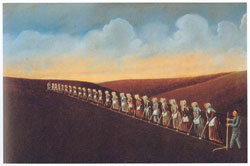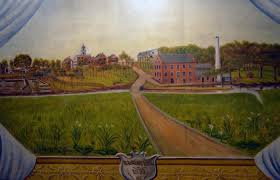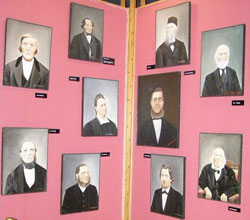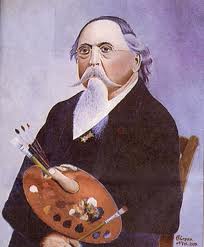|
Utopia on the Prairie–Olof Krans Folk Painting
 Bishop Hill Colony was founded in 1846 by a group of 1,000 immigrants under the leadership of Erik Jansson that fled Sweden for religious freedom. On the Illinois prairie, the “Janssonists” formed a utopian communal society which thrived. Although the communal experiment only lasted sixteen years, the economic and historical impact on the area was significant. Bishop Hill Colony was founded in 1846 by a group of 1,000 immigrants under the leadership of Erik Jansson that fled Sweden for religious freedom. On the Illinois prairie, the “Janssonists” formed a utopian communal society which thrived. Although the communal experiment only lasted sixteen years, the economic and historical impact on the area was significant.
In 1850, as a twelve year old, Olof Krans (born Olof Olson) immigrated to Bishop Hill Colony with his parents. There he attended school for two years and then was assigned the job of ox boy, and later he worked in the blacksmith and paint shops. When President Lincoln called for troops to defend the Union, Bishop Hill raised an entire company. Olof was one of the volunteers. As was custom for Swedes when they joined the Army, he changed his name from Olson to his choice of Krans. He was only in the Army a short time as he fell ill and was soon discharged. After his return to Bishop Hill, he found a disbanded community and the woman of his dreams had married someone else. With his dreams shattered and in deep depression, he spent four years earning his living by operating a horse-drawn photographic studio. It is thought that many of the portraits of the members of the Bishop Hill colony that he painted later on were based on photographs taken during this time.
By 1867, Olof’s life was turning around. He moved to Galva, the next town, married and became a house and commercial sign painter as well as hung wallpaper. He also did interior decorating—wood graining, and faux marble. His early creativity was on display with the window sills of one house becoming jungles of plants; vines grew on the pew ends of Galva’s Swedish Methodist church, while the ceiling of the Lutheran church was transformed into an azure sky spangled with golden stars.

Portion of Olof Krans' Stage Curtain
Painted 1895, depicting Bishop Hill in 1855

Small sample of portraits painted by Olof Krans
starting in 1895, depicting members
of the Bishop Hill Colony |
Olof did not begin to paint images of his memories of the Bishop Hill Colony until later in life. In 1895 he was asked to paint a stage curtain for a new community center in Bishop Hill. The resulting image was his depiction of Bishop Hill in 1855 and became a turning point in his career.
In 1896, inspired by the fiftieth anniversary of the founding of Bishop Hill, he started painting scenes from his childhood. These compelling images were first exhibited in ceremonies that marked the anniversary. The paintings depict the early Swedish immigrants planting, sowing and reaping against the backdrop of the vast prairie. He also painted a significant number of portraits of the men and women of Bishop Hill. From a historical perspective, these paintings have provided an unprecedented window into the Bishop Hill Colony. |
Olof Krans donated many of his paintings to Bishop Hill. As a consequence, today, about 100 of his paintings can be seen on display in the Bishop Hill Museum. Olof Krans died on January 4, 1916. He is recognized as one of America's foremost folk artists. His primitive style and attention to detail has provided not only wonderful works of art but valuable historic documents as the workings of the Bishop Hill utopian community.Krans generally painted oil on canvas. His landscapes generally have a colorful palette while his portraits are monochromatic and austere. Some attribute this to the personality of the people, but there is also some belief that the portraits were drawn from photographic images that would have been solemn as was common for photography from that time. |

Olof Krans Self-Portrait |
Search for folk art paintings on Dig Antiques.
References:
- A Prairie Dream Recaptured, David G. Lowe, American Heritage Magazine, October 1969.
- Digital Photography of Olof Krans Paintings, Why are they called Teddy Bears?.
- Krans, Olof, Encyclopedia of American Folk Art, Google books.
- Olof Krans, Wikipedia.
- Bishop Hill, (video), Illinois Historic Preservation Agency.
|
|
Utopia Travels
This year on our trip back to California from New York we decided to stop in Bishop Hill, IL. We had heard about Bishop Hill from antique dealer friends that have exhibited in its annual summer antiques show. Alas, we wouldn't be able to attend the show but we could spend an afternoon touring the old buildings and learning about this "Utopia on the Prairie".
Located about 20 miles off of I-80 and 160 miles west of Chicago, it was an ideal place to stop and break up our trip. With a perfect fall afternoon, we toured the open buildings and museums and learned about the first real wave of Swedes to immigrate to the US. We stayed overnight in a local inn and had an enjoyable time. The highlight of our short stay was viewing Olof Krans' paintings at the Bishop Hill Museum. With approximately one hundred of his paintings and the original stage curtain, we had our fill of eye candy!
To top off our visit at the museum, our docent was a descendent of the Bishop Hill colonists and grew up in Bishop Hill. She indicated that not everyone was all that happy with Olof's portraits as there were some that did not think the portrait was too kind to themselves or their relatives. She swore that today she can see spitting images of at least two of the portrait descendants. Aah, genetics are a wonderful thing! The other story she shared with us was the improbability that these portraits actually survived. When she was a child, the portraits were stacked along the walls of the old Colony Church. She and her friends would play school with them, sitting them on chairs and pews as if they were their pupils. It would have been a shame if these wonderful folk art paintings hadn't survived. Thankfully, beginning in the early 1960s, the idea took hold that the buildings and paintings needed to be preserved for future generations.
We hope you are enjoying our newsletter. If you have a chance, please visit the Shops on Dig Antiques and don't forget to take advantage of our search engine as you are looking for antiques.You can have your own shop for only $149/year. Learn more here.
Sincerely,
Tom & Sheila Baker
diginfo@digantiques.com
We Dig It...do you? Dig Antiques - Real stuff without the fluff.
 
|
|
|
Search Showcase
Have you been digging for antiques recently?
|
|
September 2013 Top Searches
Below is a summary of the twenty most popular search phrases last month.
1. cloth doll
2. dry sink
3. Amish
4. paint
5. American country smalls
6. cupboard
7. childs painted chair
8. gameboard
9. Adirondack
10. bed
11. paint decorated box
12. redware
13. painted miniature basket
14. coverlet
15. Nantucket basket
16. hooked rug
17. lantern
18. country store
19. sampler
20. folk art
|
|

 Bishop Hill Colony was founded in 1846 by a group of 1,000 immigrants under the leadership of Erik Jansson that fled Sweden for religious freedom. On the Illinois prairie, the “Janssonists” formed a utopian communal society which thrived. Although the communal experiment only lasted sixteen years, the economic and historical impact on the area was significant.
Bishop Hill Colony was founded in 1846 by a group of 1,000 immigrants under the leadership of Erik Jansson that fled Sweden for religious freedom. On the Illinois prairie, the “Janssonists” formed a utopian communal society which thrived. Although the communal experiment only lasted sixteen years, the economic and historical impact on the area was significant.

